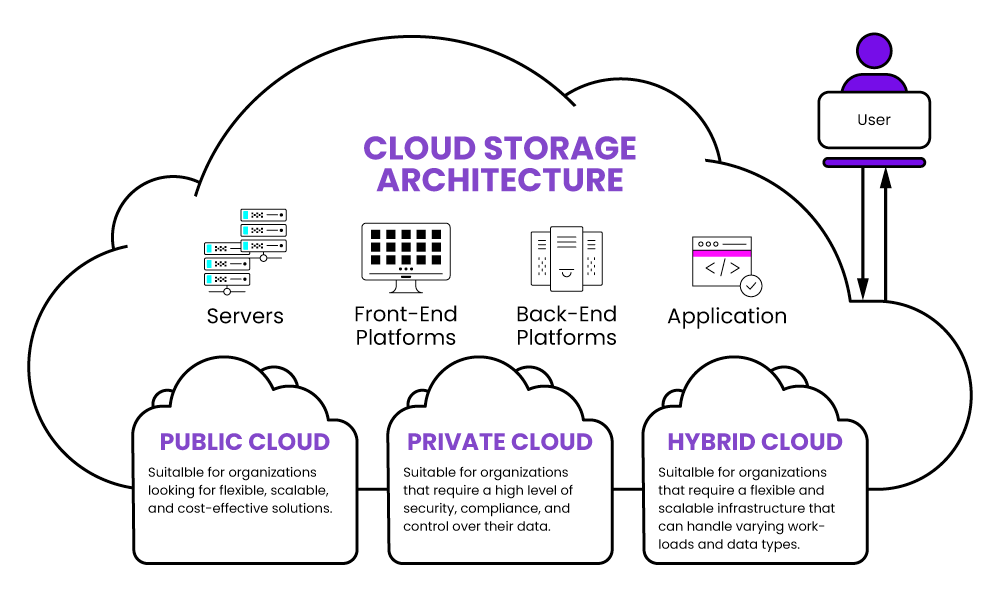Cloud Storage: A Complete Guide in Simple Terms

Are you wondering about cloud storage? We discuss what cloud storage is, why you need it, and everything you need to consider for your business cloud storage solution.
What is Cloud Storage?
Cloud storage is a way for organizations and individuals to store their data online accessible from any location securely. Cloud storage offers many benefits, including the following:
- Flexibility
- Scalability
- Disaster recovery
- Rapid deployment
What Is Cloud Storage and Why Is it Important for My Business?
Cloud storage is a model of storage as a service (STaaS) where users can keep and access data on a collection of third-party or on-premise servers, commonly called “the cloud.” What makes this model unique from traditional client/server data access models is that cloud storage supports several capabilities like web access, computing features, security measures, and resilience through storage redundancy.
Unlike a server-based infrastructure where storage and data access are predicated on users accessing a single server (set of servers), cloud infrastructure uses a pool of shared storage and computing resources to distribute access and processing power associated with storage. This means that storage can function as a “service” rather than a feature. The cloud platform breaks down barriers to access and allows storage to operate in several new contexts, including web access and remote syncing to local machines.
Furthermore, cloud storage is much more cost-effective than using on-premise solutions for the most part because cloud infrastructure offers several clear advantages in several categories:
- Flexibility: Cloud storage is configured for access across several platforms and, typically, through web interfaces. This same feature is somewhat possible through browsers with FTP capabilities, but those don’t come with the features and ease of use accompanying cloud servers.More importantly, cloud storage facilitates access through automation and API calls. When data is stored in the cloud, those cloud providers will usually provide extensive, secure methods to access data through a variety of means, including authorized third-party apps and high-performance computing algorithms situated in the cloud.
- Scalability: Cloud “servers” are distributed, shared resources that enable data storage across them. It’s much easier to add or remove storage as needed, which makes it much more feasible to scale storage capacity in a short period.
- Resilience and Disaster Recovery: Cloud storage is robust and resilient, and it can support several layers of backup and recovery. This means that your data isn’t bound to the challenges of past, server-driven infrastructure—namely, potential loss of data due to error, physical damage, or lack of backups. Additionally, if local systems fail, storage can facilitate rapid recovery of all data, configuration settings, and system logs.
- Costs: Cloud infrastructure is, in most cases, less expensive than on-premises data centers of comparable size and scale.
- Availability: Storage almost always provides ways to sync data across computers, devices, and other systems in real-time. A change to a file or a directory will propagate across devices no matter where they are so long as they are connected to a network. Following that fact, data is usually readily available to almost any user authorized to access it. It also allows you to use granular access controls to control where and to whom data syncs.
- Compliance: Compliance is complicated, particularly in high-risk industries like healthcare, defense contracting, or payment processing. Managing compliance internally calls for a dedicated IT team, dedicated compliance experts, and quite often one or more executives focused entirely on compliance issues. Third-party cloud providers can mitigate this because they allow their customers to outsource compliance’s technical and administrative demands. For example, a provider can configure their servers and operations to meet HIPAA requirements, offer a standard Business Associates Agreement, and sell cloud storage to hospitals and other covered entities who must adhere to HIPAA.
With these advantages in mind, cloud storage isn’t perfect and does have a few limitations:
- Network Connections Required: To get the full benefit of cloud storage, you must have a persistent network connection. In modern times, this doesn’t seem like much of a problem. But if the network goes down due to an emergency or other issues, then access to the cloud is essentially cut off (unless there are on-premise backups).
- Security: Cloud platforms are secure, and providers often go to extreme lengths to implement the highest possible levels of security. At the same time, storage systems can become centralized targets for attacks. If an attack on a cloud application is successful, it can theoretically propagate to connected systems or customers building mobile apps on that infrastructure. This is typically less of an issue for storage, but it bears mentioning. However, more relevant to storage users are network-based attacks like DDOS attacks that can cripple file access.
- Slower for Certain Functions: Cloud storage is often relatively fast, but it can be slower when compared to on-prem servers. Cloud backups can be slower to create and restore than local ones, which is why many organizations use hybrid cloud and on-premise backup solutions.
In our modern computing context, however, storage offers many more advantages than disadvantages.
How Does Cloud Storage Work?
Cloud storage is a complex technology that involves a distributed network of servers, storage devices, and software systems working together to provide a secure, reliable storage solution for data. Cloud storage allows individuals and organizations to store files and data on remote servers that are managed and maintained by a third-party service provider.
First, the user uploads their data to the cloud storage, typically after creating an account with a cloud storage provider and installing their software on their device. This allows the user to place their data in a location on their device so it will be automatically synced to the remote server.
Data stored in the cloud can be accessed from any device with an internet connection by an authorized user. Cloud storage space allows users to share files and folders with others easily by setting permissions and access controls for data.
From a technical perspective, a distributed system of servers and storage devices connected over the internet are at the heart of how cloud storage works. Whenever a user uploads a file to cloud storage, the file is broken up into smaller pieces and distributed across multiple servers and storage devices, which are often located in different geographic regions for redundancy and better performance.
Cloud storage providers typically use object storage technology, which stores data as objects rather than files or blocks. Object storage is highly scalable, flexible, and can handle large amounts of data. However, some cloud storage solutions use block or file storage technologies.
Cloud storage providers typically employ a range of security measures to ensure data is secure and protected. Cloud storage security measures include encryption, access controls, and backups.
Cloud storage solutions also protect files against hardware failures or data loss. They may offer features such as versioning, which allows users to access and restore previous versions of files, and store multiple copies of data on different servers.
When users access data from the cloud, the provider retrieves the necessary objects from the storage system and sends them to the device over the internet. This process is typically very fast, especially if the provider has servers located near the user’s geographic region.
How Does a Cloud Storage Strategy Differ From Alternatives?
There are several storage solutions available, including direct-attached storage (DAS), network-attached storage (NAS), storage area networks (SANs), and cloud storage. For the most part, for enterprise-level environments only SANs and cloud storage have the potential to offer the scaling and performance demanded by users.
SANs are dedicated, high-speed networks that provide access to block-level storage via devices, such as disk arrays or tape libraries, over a high-speed network, using protocols such as Fibre Channel or iSCSI. SANs are often used in enterprise-level environments where there is a need for high-performance, scalable storage solutions. SANs provide a centralized storage platform that can be easily accessed by multiple servers or applications, enabling them to share data and resources.
SANs typically consist of multiple storage devices, connected to a network fabric that provides high-speed connectivity between the devices and the servers that access them. The storage devices can be configured in various ways, such as RAID arrays or clustered configurations, to provide high levels of reliability and availability.
SANs offer several benefits over other storage solutions, such as direct-attached storage (DAS) or network-attached storage (NAS), including higher performance, scalability, and flexibility. SANs also allow for more advanced storage management features, such as storage virtualization and thin provisioning.
There are some key differences between SANs and cloud storage:
First, SANs are typically located on-premises within an organization’s data center, while cloud storage involves storing data on remote servers that are accessed over the internet. This is related to another issue: ownership. SANs are owned and managed by the organization itself, while cloud storage is typically provided by a third-party cloud service provider.
Scalability is another issue, because ultimately cloud storage is more scalable. Cloud storage allows businesses to quickly and easily increase their storage capacity as needed, without having to purchase additional hardware. SANs have a more fixed amount of storage that can be expanded, but this usually requires additional hardware and setup.
Cloud storage is also more accessible, with data in reach from anywhere with an internet connection, while SANs are typically accessed only within the local network.Finally, SANs require an initial investment in hardware and software, as well as ongoing maintenance costs. Cloud storage typically requires a monthly or annual fee and eliminates the need for businesses to purchase and maintain their own hardware and infrastructure.
What Is Cloud Storage Architecture?

You may hear terms like “the cloud,” “cloud servers,” or “cloud infrastructure” interchangeably. More accurately, cloud storage (or anything deemed cloud-based) is a network of components that form an architecture supporting storage, access, and security.
Generally, you can think of a ‘‘cloud” as a collection of components that cover the following:
- Front-End Platforms that control user interfaces, access, and other public-facing functions.
- Back-End Platforms that handle the logistics of user requests, automated processes, file management, and so on.
- Databases handling the storage and retrieval of the data in the cloud, often distributed across multiple physical servers.
- Applications that hold the cloud together. This can include cloud file systems, automation for specific user and system actions, and even user-facing apps that provide those users with different ways to leverage the cloud storage.
With this in mind, we can broadly divide cloud storage architecture into three main categories: public, private, and hybrid. Each is a unique approach to managing data storage and computing resources in the cloud.
Public cloud. Public cloud is well known and what many of us think of when we think of cloud storage. Services like Microsoft Azure, AWS, and Google Cloud are all public clouds in that they provide access to cloud infrastructure for multiple “tenants” or users.
This means that when your organization signs up for cloud services, those services are restricted from other users through software and file systems. While you’ll have your own storage instance, that instance will share physical space on networked cloud servers with other users. This is often referred to as “multi-tenant” architecture.
Public clouds are suitable for organizations looking for flexible, scalable, and cost-effective solutions that do not require a large capital investment in infrastructure.
Private cloud. A private cloud offers what public cloud infrastructure cannot: dedicated storage and computing resources on server space in a single-tenant environment. This can provide additional security, customization, and performance depending on user needs—but at what typically amounts to much higher costs.
Private clouds are hosted on-premise or in a dedicated data center and are managed by the organization’s IT team. Unlike public clouds, private clouds offer enhanced security, greater control over data, and improved reliability. Private clouds are suitable for organizations that require a high level of security, compliance, and control over their data.
Hybrid cloud. A blend of public and private, hybrid cloud storage infrastructure allows organizations to use private cloud services where needed (either for compliance, security or performance demands) and public cloud for everything else. It is designed to offer the best of both worlds, combining the scalability and cost-effectiveness of public clouds with the security and control of private clouds.
Hybrid clouds allow organizations to store and manage sensitive data on private clouds while leveraging public clouds for non-sensitive workloads, such as testing and development, or peak demand periods. Hybrid clouds are suitable for organizations that require a flexible and scalable infrastructure that can handle varying workloads and data types.
What are the 3 Main Types of Cloud Storage?
The three main types of cloud storage are file storage, block storage, and object storage.
File Storage
File storage is a type of cloud storage that stores data as files, similar to how data is stored on a traditional file system. Users can organize their data into folders and subfolders, and access it using familiar file-based protocols such as NFS and SMB. File storage is commonly used for storing structured data such as databases and application data.
Block Storage
Block storage is a type of cloud storage that stores data in fixed-size blocks, similar to how data is stored on a traditional hard drive. Users can create and manage virtual hard drives, and access them using block-based protocols such as iSCSI. Block storage is commonly used for storing data that requires low latency and high performance, such as virtual machine images and databases.
Object Storage
Object storage is an approach to cloud storage that stores data as objects, not blocks or files. Each object is assigned a unique identifier, or key, which allows it to be accessed and retrieved from any server in the storage system. Object storage is highly scalable, flexible, and can handle large amounts of data. This type of storage in cloud is commonly used for storing unstructured data such as images, videos, and documents.
What is Cloud Storage Security?
Measures and protocols for security on cloud storage protect data stored in the cloud from theft, unauthorized access, or loss. These include:
Encryption. Cloud storage services typically use encryption to protect data both in transit and at rest. Data is encrypted using a unique key, which is only accessible to authorized users.
Access control. Access control measures such as user authentication, multi-factor authentication, and role-based access control (RBAC) are used to ensure that only authorized users can access and modify data stored in the cloud.
Network security. Cloud storage providers use network security measures such as firewalls, intrusion detection and prevention systems (IDPS), and network segmentation to prevent unauthorized access to data.
Backup and disaster recovery. Cloud storage providers implement backup and disaster recovery solutions to ensure that customer data is protected and recoverable in the event of a natural disaster, cyber attack, or other unexpected event.
Compliance. Cloud storage providers must comply with various industry-specific regulations and standards, such as PCI DSS, HIPAA, and GDPR, to ensure that customer data is secure and protected.
Monitoring and logging. Cloud storage providers monitor their systems for potential security threats and maintain detailed logs to track and investigate any suspicious activity.
It’s also important for individual users to take appropriate measures to protect their data, such as using strong passwords, enabling multi-factor authentication, and regularly backing up data.
Advantages and Disadvantages of Cloud Storage
Cloud storage has various advantages and disadvantages compared to network attached storage (NAS). Some of the most important pros and cons of cloud storage center around cost, scalability, reliability, and access.
Advantages of Cloud Storage
Storing data in the cloud has several advantages over traditional on-premises storage. Some of the benefits of cloud storage include:
Scalability. Cloud storage enables users to scale their storage needs rapidly and easily, without having to invest in expensive hardware and infrastructure.
Cost-effectiveness. Cloud storage can be more cost-effective than on-premises storage, as it eliminates the need for businesses to purchase and maintain their own hardware and infrastructure.
Accessibility. Data stored in the cloud can be accessed from anywhere with an internet connection, making it easier for employees to collaborate and work remotely. Cloud storage providers often offer features specifically designed for file sharing and real-time collaboration, such as file sharing links, access controls, versioning, and commenting.
Reliability. Cloud storage providers typically offer high levels of reliability and availability, with redundant systems and backups to ensure that data is not lost in the event of a hardware failure or other outage.
Security. How secure is cloud storage? Cloud storage providers typically offer robust security measures, including encryption, access controls, and backups, to protect data stored in the cloud from unauthorized access, theft, or loss.
Flexibility. Cloud storage can be easily integrated with other cloud services, such as cloud computing and cloud-based applications, to create a complete cloud infrastructure that meets the needs of businesses of all sizes and industries.
Overall, storing data in the cloud can provide businesses with greater scalability, cost-effectiveness, accessibility, reliability, security, and flexibility than traditional on-premises storage solutions.
Disadvantages of Cloud Storage
While storing data in the cloud has many advantages, there are also some potential disadvantages to consider:
Dependence on the internet. Cloud storage requires internet access for data access, which can be a disadvantage if there are connectivity issues or if internet access is not available.
Security concerns. While cloud storage providers implement robust security measures, there is still a risk that data stored in the cloud can be compromised in the event of a cyber attack or data breach.
Reduced control. Storing data in the cloud means that businesses may have limited control over the infrastructure and security measures in place, as they are reliant on the cloud storage provider.
Compliance issues. Depending on the industry and location, storing data in the cloud may be subject to regulatory compliance requirements, which can be challenging to navigate.
Data transfer costs. Depending on the cloud storage provider and the amount of data stored, there may be additional costs associated with transferring data in and out of the cloud.
Downtime. Even though cloud storage providers offer high levels of reliability and availability, there is always a risk of downtime due to technical issues, which can impact access to data.
Why Is it Important to Have a Cloud Storage Strategy in Place?
Cloud storage isn’t simply something that you drop into your business and hope for the best. This strategy might work for basic needs (short-term user storage of unimportant files) but not for actual, enterprise-level use.
A cloud strategy can help you situate storage in a way that maximizes efficiency, usability, and security across your organization. A hybrid cloud strategy might include considerations like the following:
- What are you using the storage for? Are you performing high-performance cloud computing? Are you relying on cloud backups for compliance? Do you need to support a remote workforce? All of the above? The type of storage you need will dictate what platforms or architecture you use.
- What are the demands of your industry? Do you face strict regulations or privately-imposed compliance standards? How rapidly must data be made available and to whom? Most importantly, what kinds of data are you managing, and how can you best leverage the cloud to keep it accessible?
- What is your budget? Different types of storage call for different budgets. How much can you allocate for applications or additional features like backups or priority access? Can you afford (or do you need) private cloud infrastructure? What are the business implications of cloud storage infrastructures?
- What kind of workloads must you support? If you’re moving to or expanding your storage, it’s most likely the case that it isn’t just to let employees grab files from the web. Are you looking to build complex and high-volume web applications? Do you regularly run high-performance algorithms on your data for analytical or business intelligence purposes? Are you building machine learning or AI programs that call for specific capabilities?
How vital are interoperability and hybrid systems? Resilience and disaster recovery are critical to most businesses. The most effective way to maintain resilience and elasticity is to have responsive systems that support short- and long-term storage goals. That could mean hybrid cloud storage or a mix of cloud and physical on-premise servers
High-Performance Cloud Storage with WEKA
Cloud storage is often inseparable from cloud computing. The best way to make the best use of your storage is to integrate it into computing functions like analytics, audit logging, and other processing. As your storage infrastructure scales and becomes more complex, it is integral that you have a file system in place that can handle rapid access, transfer, and compute without sacrificing security or flexibility.
WEKA is a cloud-native platform that provides all of these features and more to support your machine- and deep-learning workloads.
These open source cloud storage features include the following:
- Autoscaling storage for high-demand performance
- On-premises and hybrid-cloud solutions for testing and production
- Industry-best, GPUDirect Performance (113 Gbps for a single DGX-2 and 162 Gbps for a single DGX A100)
- In-flight and at-rest encryption for GRC requirements
- Agile access and management for edge, core, and cloud development
- Scalability up to exabytes of storage across billions of files
Cloud storage is an integral part of complex computation and research workloads.It isn’t enough to have a cloud provider that just gives you volume without speed and scalability. To learn about how WEKA gives that to you, contact us to learn WEKA.





